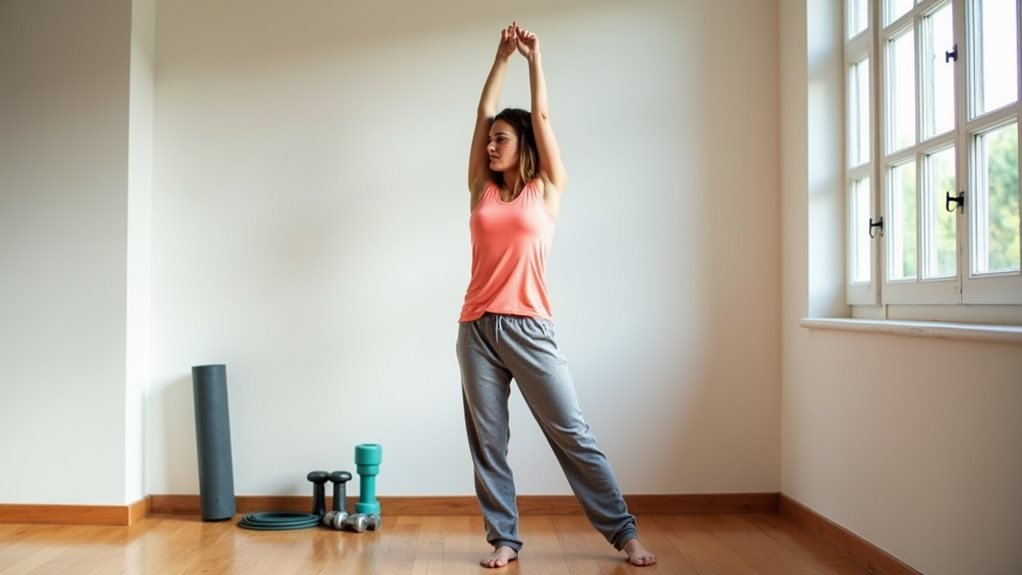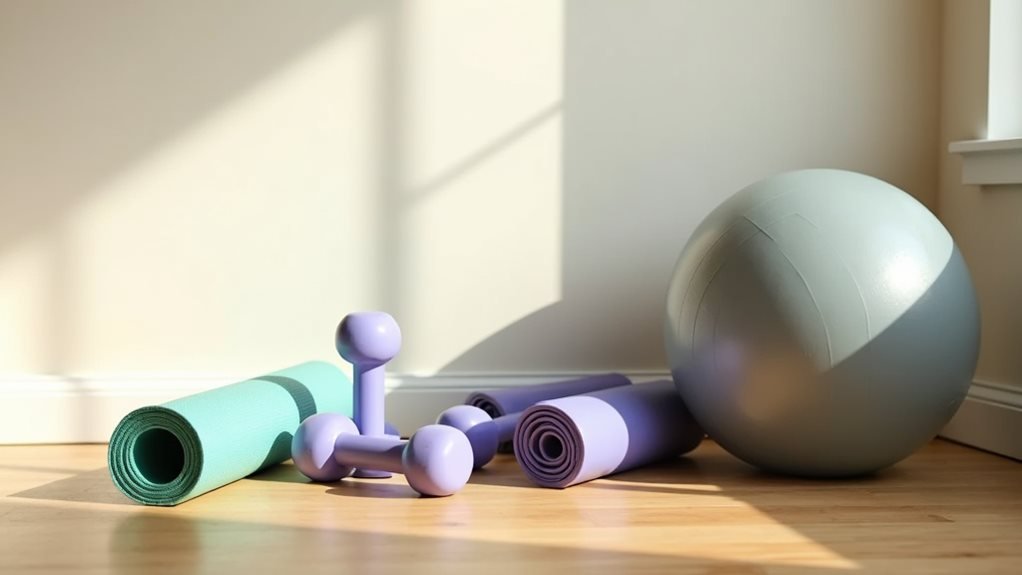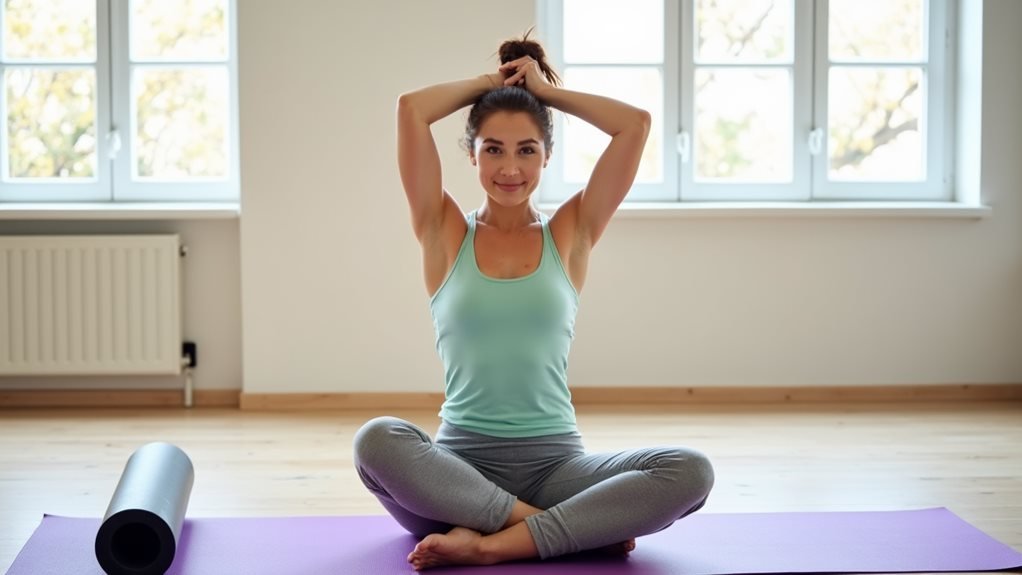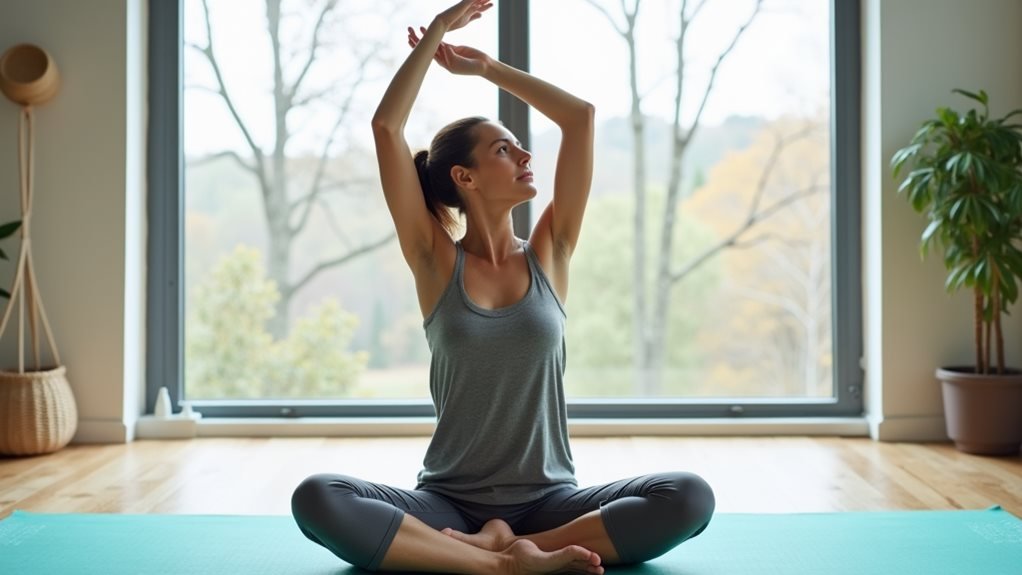While many fitness enthusiasts swear by high-intensity training, I've found that starting slow actually helps you go far. As someone who's guided countless beginners through their first workouts, I know that low-intensity exercises can build the foundation you need for long-term success. You don't need fancy equipment or complex routines to begin transforming your fitness level – just a willingness to take that first step. Let me show you how simple movements, performed mindfully, can lead to remarkable changes in your strength, flexibility, and overall well-being.
Key Takeaways
- Begin with 30-second movements followed by 30-second rest periods to build endurance without overwhelming yourself.
- Focus on basic bodyweight exercises like modified squats, lunges, and marching in place for a low-impact start.
- Aim for 10-20 minute sessions twice weekly, gradually increasing duration as fitness improves.
- Incorporate gentle stretching between exercises to maintain flexibility and prevent muscle strain.
- Monitor your heart rate to stay at 50% of maximum capacity while performing low-intensity movements.
Getting Started With Exercise
Three key elements make starting an exercise routine more approachable than you might think.
First, you don't need fancy equipment – your body weight provides plenty of resistance for effective workouts. Low-impact exercises like walking can help beginners build cardiovascular endurance without stressing joints.
Second, you can start at home, eliminating the intimidation factor of a gym.
Third, you've got options for low-impact movements that won't stress your joints.
I'll tell you straight: begin with basic movements like squats, lunges, and modified jumping jacks (I call them jack taps). These foundational exercises target multiple muscle groups while protecting your joints. Taking just 40 seconds per exercise gives you an effective workout while maintaining proper form. Your goal should be to maintain 50% of max heart rate during these exercises.
Want structure? Try this: 30 seconds of work followed by 30 seconds of rest. Repeat for 10-20 minutes.
Here's the kicker – you don't need to kill yourself to see results. Start with walking, light jogging, or cycling at a steady pace. Can't run? Don't. Swimming and elliptical machines offer excellent alternatives. The key is consistency, not intensity. Track your progress with steps, heart rate, or simply how you feel.
Simple Workouts for Beginners

Mastering simple workouts doesn't require complex routines or fancy equipment. I'll show you how to start with basic movements that'll build your confidence and strength. Let's focus on three core exercise types that form the foundation of any solid workout routine:
- Low-impact cardio moves like marching and side steps – perfect for getting your heart rate up without stressing your joints
- Bodyweight exercises including modified squats and gentle lunges – they'll build strength while keeping you stable
- Core work combining twists and planks – essential for overall stability and proper form
I recommend starting with 30-second intervals, following the work-rest patterns I've outlined. When you're doing squats, keep them shallow at first – no need to go deep until you're ready. Keep your heels planted firmly on the ground and your core engaged. If you need to pause, do it. There's no prize for pushing through pain.
Remember to breathe steadily throughout each movement. As you get stronger, you'll naturally want to increase your workout intensity. Trust me – your body will tell you when it's time to level up. Exercise bikes provide a low-impact option for building cardiovascular endurance and lower body strength while being gentle on your joints.
Choosing the Right Equipment

Start with resistance bands – they're portable, versatile, and perfect for building foundational strength. I recommend pairing these with a set of adjustable dumbbells, which'll give you plenty of room to grow without cluttering your space. The Waver Mini Vibration Plate is also an excellent addition for enhancing your workout effectiveness.
For cardio, I'd point you toward a stationary bike or under-desk elliptical. They're low-impact, which means your joints won't hate you tomorrow, and they're ideal for building endurance. If you're working from home, an under-desk option lets you multitask like a pro. These machines offer adjustable resistance levels to match your fitness progression. Magnetic resistance bikes provide up to 100 resistance levels for a smooth and quiet workout experience.
Got back issues? Don't sweat it – a recumbent bike is your new best friend. It provides excellent support while still delivering an effective workout.
And if you're tight on space (who isn't?), consider a compact walking pad. You can slide it under your couch when you're done, and it's perfect for those days when you just need to move without thinking too hard.
Building Your Exercise Routine

Building an exercise routine doesn't have to feel like rocket science. I'll help you create a sustainable workout plan that fits your lifestyle and current fitness level. Let's break it down into manageable chunks that won't overwhelm you.
Start with these foundational elements that I've tested with countless beginners:
- 30 seconds of movement followed by 30 seconds of rest – perfect for maintaining form
- Low-impact exercises like squats, lunges, and marching in place
- Two 10-minute rounds with a brief stretch break between them
I want you to begin with just 10-20 minutes, twice a week. Trust me, it's enough to build momentum. You can always step instead of jump, and march instead of run – these modifications aren't cop-outs, they're smart training. Your body will tell you what it needs.
Staying Safe While Working Out

Safety is my top priority when helping beginners start their fitness journey. I'll never compromise on this – your well-being comes first. Before you jump into any workout routine, you'll need medical clearance if you've got chronic conditions or recent injuries. Trust me, it's non-negotiable. Yoga is particularly beneficial since it involves gentle poses that put minimal strain on your joints.
| Safety Element | Why It Matters | Action Required |
|---|---|---|
| Medical Check | Prevents complications | Visit doctor first |
| Proper Form | Reduces injury risk | Learn techniques |
| Body Signals | Avoids overexertion | Monitor pain levels |
Let's get real about exercise intensity. I want you to start low and go slow – that's not just advice, it's your new mantra. Keep your heart rate at about 50% of its max and stick to low-impact activities like walking or swimming. Don't try to be a hero; this isn't about pushing limits, it's about building foundations. Resistance training can help prevent muscle wasting while staying safe.
Watch your form like a hawk, stay hydrated, and never skip your warm-up. If something hurts, stop immediately – no questions asked. Keep emergency contacts handy and always let someone know when you're working out. Remember, smart exercise is safe exercise, and I'm here to keep you on track.
Frequently Asked Questions
Can I Do Low-Intensity Workouts While Recovering From a Cold?
I recommend low-intensity workouts during cold recovery if your symptoms are mild and above the neck. However, avoid exercise if you have fever, body aches, or severe symptoms.
How Long Should I Wait Between Workouts to Avoid Overtraining?
I recommend waiting 24-48 hours between workouts for major muscle groups. If you're new to exercise or doing intense workouts, you might need 48-72 hours for proper recovery.
Should I Exercise Before or After Eating My Main Meals?
I've found that exercising before meals works best for me. It boosts my metabolism and improves digestion. However, if you prefer post-meal workouts, just keep them light and wait 2-3 hours.
What Time of Day Is Best for Low-Intensity Workouts?
I recommend choosing a time that fits your schedule consistently. Morning workouts can boost metabolism and energy, while afternoon sessions fight fatigue, and evening workouts help reduce daily stress.
Can I Combine Low-Intensity Workouts With Other Forms of Exercise?
I love how you're thinking about exercise combinations! You can definitely mix low-intensity workouts with HIIT, strength training, cardio, or flexibility exercises to create a well-rounded fitness routine that suits you.
